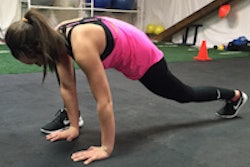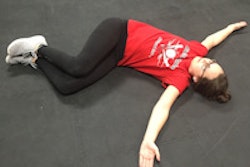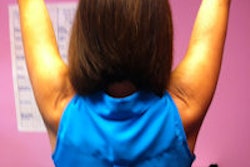
It seems like everybody is under the constant stress and strain of always having to do more -- more appointments, more calls, more meetings, more time at the computer, etc. Not surprisingly, we are also seeing that workers are experiencing more pain and injury in areas of the neck, shoulders, and upper back. If the overuse is significant enough, we can even see problems in the lower back and hips (we'll address that in the next article).
What should a sonographer do?
 Doug Wuebben and his daughter.
Doug Wuebben and his daughter.It would be great to do less. It would be fun not to work so much. It would be great to take more days off -- or get someone else to do those studies.
After that daydreaming session is over, we know we need to find a solution to the problem. We need a solution that doesn't take hours out of our already busy daily schedule, that can be performed while at work and in a short amount of time, and that makes us feel amazing.
It's not impossible; you can accomplish much by following a few simple posture guidelines. During your workday, you can do simple stretching exercises and movements that help get you into proper alignment -- and keep you there.
Let's make sure that the "pain in the neck" isn't from the physical aspect of your workday.
Good posture
First, we need to make sure that your posture is putting you in the best position to help alleviate some of the problems. The normal human head weighs approximately 8 lb. For every inch forward that your head moves out of its proper position, you exponentially increase the stress and strain on the head, neck, and shoulder region. You can literally be carrying the equivalent of 30 to 40 lb of stress and strain on the neck joint.
If you maintain this poor posture day after day for long periods of time, you will run into problems. Once you learn to maintain good posture for the day and use proper body mechanics, we can then look to eliminate the pain and problems.
We also want to make sure you're in a neutral position. We don't want the shoulders too far forward or too far back. We don't want the hips tilted to the front or back. Good position and posture can, in and of itself, help clean up many of the problems we have.
What we love about the following three stretches is that you can do them at work. They can be done in a short amount of time, and the results will be immediate.
Ankle grab deep-breathing exercise
This is a simple exercise and stretch. Keep in mind: We want to learn to breathe through our diaphragm and not be a "chest breather."
How do you know if you're a chest breather? Sit up nice and tall in your chair and take five deep breaths. Did your chest and shoulders rise up and down? If they did, you are a chest breather, which can lead to a number of issues: tight neck, shoulder problems, upper back problems, headaches -- and the list goes on.
To combat this and learn how to breathe from your diaphragm, try this ankle grab exercise:

- Sit with your back straight on the edge of your chair. Try to find a chair that doesn't roll and doesn't have wheels.
- Simply bend over and grab your ankles. Bring your chest to your thighs and work to get your head down to your knees (figure 1).
- Now take six to eight deep breaths, drawing in for four to five seconds and blowing out for four to five seconds. You should feel your stomach and intercostal muscles (along your love handles!) start to work. Because you are "pinning" your chest down, in order to breathe you have to take air in using the diaphragm. You might also notice a nice stretch in the lower back as you sit up.
This is an excellent exercise to do four to five times throughout the day when you feel your neck and shoulders getting tight, or you feel stress. It only takes a few minutes, but it can make you feel great.
Overhead reach
We want to get ahead at work, so we spend more time at our desk, work to get in one more client, and push to do more and more. If we spend too much time working with the head forward, shoulders rolled, and hips tucked, we risk repetitive-use injuries that will start taking a greater toll on our bodies and our performance levels. We end up doing less, but taking more energy to do it. We work harder to become less effective and less efficient!
So what can we do? Take a minute to perform this next exercise -- the overhead reach -- a few times a day. It can offer huge positive results, and you never have to leave your desk:
- Sitting at your desk or standing behind your chair, reach both arms overhead as high as possible, with palms facing in and thumbs pointing behind you (figure 2).
- Now here's the tricky part. As you extend your arms overhead, push your shoulders back -- think of pinching a pencil between your shoulder blades (figure 3).
- Keep reaching as high as you can, and at the same time, blow your breath out as if you were blowing out five huge candles. Inhale through your nose and exhale through your mouth.
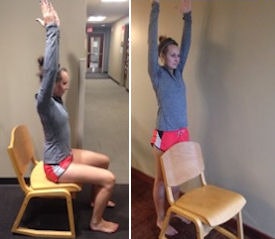 Figure 2.
Figure 2.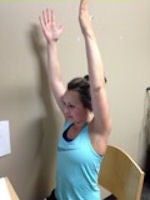 Figure 3.
Figure 3.This should open up your chest, allowing you to breathe easier, while at the same time relieving stress and strain in your neck and shoulders.
Doorjamb pull
The final movement is another simple, quick exercise that you can do almost anytime during the day. All you need is a door and yourself:
- Stand in a doorway, facing the opening. Using your arm closest to the door frame or doorjamb, put your elbow into your hip and grab the doorjamb with your hand (figure 4).
- With the other arm, reach over the top of your head (your arm should be covering your ear and not going in front of your face or behind your head). With your hand, also grip the doorjamb or door frame.
- To start the stretch, push your hip forward and into the elbow that is pressed against it. At the same time, lean away from the door frame, getting a stretch through the arm that is extended overhead.
- Hold the stretch for 20 to 30 seconds and then do the other side. A training tip here is to make sure that you're keeping your hips square or pushing the hip that is against the elbow forward. If you let your hips rotate, you'll lose some of the stretch effect from the exercise.
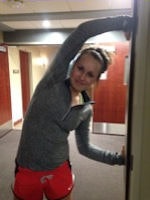 Figure 4.
Figure 4.Finding relief
Doing these exercises throughout the day will help you find relief. When you start to feel stiffness, tightness, or any pain in the neck, shoulders, or back area, use one of these movements to help rid yourself of issues that arise from sitting, straining, and being in poor posture positions during the day.
In this article, we've given you a few simple tips to begin eliminating your pain and injuries. When we present at conferences, we emphasize that our education is not a pill that you can swallow and make everything better. Back when I had my debilitating shoulder issues, I was willing to do anything to help myself. I was lucky to find a way through my friend Mark (Rozy) Roozen, a strength and conditioning specialist.
While I was fortunate to have my colleague to turn to, I was also smart in that I listened to him. That was just the beginning. I had a lot more to learn, and once I did, the results were incredible. My reward was in the end result, but it has also come from the journey itself. You feel amazing when you not only correct a horrendous malady, but also learn and grow exponentially from it.
By the way, I would like to thank my daughter Brooke for her help in demonstrating the exercises. She is at college and Dad misses her.
To get more exercises, stretches, and movements that can help you live free of pain, email us at [email protected] and ask for a free copy of "The Right Moves" for wrists and arms.
Doug Wuebben is a registered echocardiographer and also a consultant, international presenter, and author of e-books in the areas of ergonomics, exercise and pain, and injury correction for sonographers. He has also been published on the topics of telemedicine and achieving lab accreditation. Mark Roozen is a certified strength and conditioning specialist, a certified personal trainer, and a fellow of the National Strength and Conditioning Association (NSCA). He has been in the strength, conditioning, and performance field for over 28 years. Wuebben and Roozen are co-founders of Live Pain Free -- The Right Moves. Email [email protected] or go to coachrozy.com for more information on programs or speaking requests or if you have any questions or comments.
The comments and observations expressed do not necessarily reflect the opinions of AuntMinnie.com.




